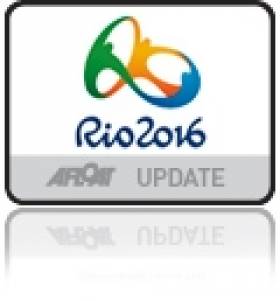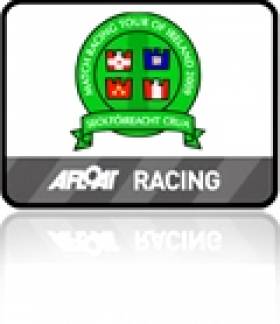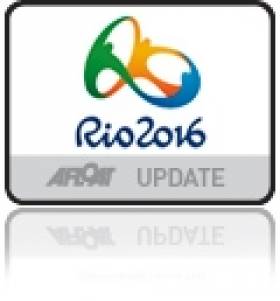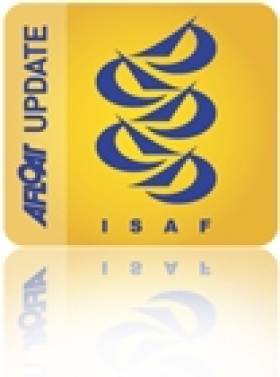Displaying items by tag: ISAF
#swchyeres – After missing the gold fleet cut at both Miami and Palma ISAF World Cup regattas this year, Ireland's Olympic sailor Annalise Murphy showed the depth of her ambition in France this afternoon when she opened her Laser Radial account at the final round of ISAF's World Cup in Hyeres with a race win and a third place to lie just two nett points off the overall lead after the first three races.
After a fantastic day afloat in consistent 15–knot breezes, Annalise lies second overall tonight to Belgium's Evi Van Acker tonight and except for a slip in race two might well be heading up her 79–boat fleet. The Dubliner shares the same four points as the Belarussian Tatiana Drozdovskaya with only seven seven points separating the top ten.
Murphy was as far back as 28th after counting a 27th in race two but bounced straight back with a third in race three to be right in the frame in the early part of this qualification round.
It was a significant performance in the more than forecasted winds and in a fleet that contains the very best sailors in the world including two of the three London 2012 Olympic medallists. Results here.
Tweeting after coming ashore, Murphy told her followers: "I had a 1st, a shocker of a 27th and a 3rd today which should put me into third overall. Significant improvement from Palma!"
Van Acker looked to banish her Palma demons as she took two race wins and a fifth to lead in Hyères. The Belgian racer missed out on a podium spot at ISAF Sailing World Cup Mallorca as she engaged in a battle for silver with Tuula Tenkanen (FIN) in the Medal Race. She finished the Medal Race in 10th and fell to fourth, missing out on a medal. A strong performance in the Hyères has put her on the right route at the early stage of the event.
ISAF Sailing World Cup Melbourne gold medallist Tatiana Drozdovskaya (BLR) is third overall.
A confirmed number of 1,111 sailors racing in 765 boats from 59 nations are racing on the French Gold coast in what is a massive turnout to bring the ISAF Sailing World Cup series to a close.
In other Irish sailing team news from Hyeres, Murphy's London 2012 team–mates have also opened their French accounts each sailing three races today.
In the mens 49er skiff class Ryan Seaton and Matt McGovern are highly placed in tenth overall in the 79 boat fleet after scoring 3,6 and 7. Results here.
ISAF Sailing World Cup Mallorca gold medallists Martine Grael and Kahena Kunze (BRA) got their week off to a strong start after picking up two race wins and discarding a 14th.
The Brazilians are in familiar company atop of the leader board with many of the leading 49erFX sailors trailing them by a narrow margin.
Ida Marie Baad Nielsen and Marie Thusgaard Olsen (DEN) sit two points behind the Brazilians whilst Charlotte Dobson and Sophie Ainsworth (GBR), who took the days other race win, occupy third.
2013 World Champions and defending Hyères champions Alex Maloney and Molly Meech (NZL) found their form after a disappointing week in Mallorca. Recording a second, a discarded 19th and a third they sit in fourth.
James Espey lies 70th from 123 starters in the mens Laser division. Results here. Jean Baptiste Bernaz (FRA) took two race wins in the Laser and is the early leader in the 123-boat fleet. The French racer took two bullets from the day's opening encounters and came through with a ninth in the third and final race of the opening day.
With two fleets the remaining race victories went the way of Robert Scheidt (BRA), Jesper Stalheim (SWE), Andy Maloney (NZL) and Matt Wearn (AUS).
Ireland's Andrea Brewster and Saskia Tidey are 17th from 42 in the womens 49erfx skiff. Results here.
Two Irish Teams For ISAF Match Race Worlds in Cork
#matchracing – Two womens team are to go forward from three entries at last weekend's Irish trials for the the ISAF Women's Match Racing Worlds hosted by Royal Cork Yacht Club in June. After a short notice event in Howth last weekend Mary O'Loughlin (and her team of Karena Knaggs, Lynn Reilly and Niamh McDonald) Laura Dillon (and her team of Maria Coleman, Carol O'Kelly and Breffni Jones) are to go forward for the invitation only event. As hosts Ireland is fortunate to benefit from two wild card invitations after one foreign team set for Cork pulled out of the event.
The J80 racing was tight and wind conditions were windy, approximately 15-20 knots from a westerly direction. Racing started with full rig and spinnakers, but, with the wind increasing races 2 and 3 were raced without spinnakers.
The ISAF Women's Match Racing Worlds which will be hosted by Royal Cork Yacht Club, from 3-8 June 2014.
#kitesurfing – 2014 will see Jade O'Connor continue to campaign in the Formula Kiteboard class after the Dubliner represented Ireland last year at The Kiteboard Racing World Championships in China. She finished 12th overall, her best result to date.
"This is a big year for our class, in light of our exclusion from Rio 2016. The IKA and ISAF are in negotiation for the 2020 Olympics. To that end, kiting will be included in the new next month at the Delta Lloyd EUROSAF in the Netherlands, this will be an invitational event of only 20 sailors, so it's a big honour to be chosen, and have Ireland on the start line." O'Connor told Afloat.ie
Apart from ISAF's own events kiteboarding has a highly successful world tour that will see the Dubliner compete in Turkey, Poland, San Diego, Qatar, and finishing the year in Sydney Australia. "It's amazing to be part of the tour and compete at this level. The last month has been about loosening up and getting back into the groove, when racing with 30knots of board speed you have to rely more on muscle memory, and 'get your head out of the boat' so to speak. Now I'm dialling into new equipment and starting to look for improvements in board handling, chop management, upwind angle and speed. As one of the few amateurs at this level its difficult to compete at my best all season. I've picked the Worlds in August and Sydney in December to be my standout events, I'm really excited to get going, I can feel that coiled spring in my stomach starting to wind."
#matchracing – Ireland has been granted two wild card places at the 2014 ISAF Women's Match Racing World Championships to be held at Royal Cork Yacht Club from the 3rd - 8th of June 2014.
In order to select teams following earlier selection issues, a Selection Committee composed of Cxema Pico, Brian Mathews and Gordon Davies has been appointed. The committee was requested by the ISA to decide on the process to select the skippers (and teams) that will deliver the best result for Ireland at this event, and to be as fair as possible to all of applicant skippers.
Initially four skippers had expressed an interest, although only three have confirmed that they are available for selection. It was agreed, by both selectors and competitors, that the most appropriate way to choose between the sailors would be out on the water. The selection trials will be sailed in Howth this Sunday the 13th of April, using the same J80s that will be used for the World Championships.
The three candidates are :
Laura Dillon was the only female winner of the Senior Helmsmans Championship in 1996, Bronze Medallist at the 1996 ISAF Youth Worlds and, having competed in match racing she was at one time in the top 20 ranked female match racers, and is current Irish Women's Match Racing Champion (last sailed in 2010). Her crew includes double Olympian Maria Coleman.
Diane Kissane is a 470 sailor and current captain of the Trinity College sailing team Diane was 2008 Irish Laser 4.7 champion and won the 2009 Junior Helmsmans. Her crew all have recent team racing experience, including member so of this year's IUSA championship winning team, and have all represented Ireland at the Student World Yachting.
Mary O'Loughlin was the 1997 Mirror Ladies World Champion. She was a keen match racer here and abroad when the Irish circuit was developing in the mid 2000's. She has also extensive experience sailing an Etchells. Her crew is an interesting mix of keelboat sailors and dinghy/team racers.
Based on the results of next Sunday's competition the Selection Committee will recommend two skippers to the for selection.
#corkharbour – Camden Fort Meagher, an historic fort in Cork Harbour will headquarter June's International Sailing event for women hosted by Royal Cork Yacht Club it was announced yesterday. An Irish team for the event has yet to be anounced due to late changes in the selection process.
Sixteen international teams are expected to travel and compete and will include some of the world's highest ranking sailors and potential Olympians. Entries to date have been received from New Zealand, United States, Denmark, France and the Netherlands. As Afloat reported earlier the event will also be the first stage of the Women's International match Racing Association tour.
Sponsored by Cork County Council and the Port of Cork, the World Match Racing Championship for Women is one of the world's highest calibre sporting events.
Cork Harbour renowned for its sailing throughout the world, is hosting this event directly under Camden Fort Meagher, which offers unrivalled viewing to competitors, their families, friends, supporters and general public.
Camden Fort Meagher will be the Event Head Quarters for this international sailing event. This will be a first for the fort. Paul Brierley, project coordinator for Camden Fort Meagher said "we are delighted to be part of this world event, which will allow competitors and spectators to enjoy the wonderful ambience of this historic fort and an ariel view of the racing from its spectacular deck". Royal Cork Yacht Club Admiral, Pat Lyons, explains that "Cork and the Royal Cork Yacht Club were chosen over other locations, such as Long Beach California". "This speaks volumes" he said, "of the commitment and expertise we have in the yacht club and in Crosshaven to be chosen to host such a prominent event here in Cork Harbour".
However not all the sailing will take place in the harbour from the 3rd to 8th of June. On 6th of June the River Lee will play host to a one day event, which will bring the international sailing competition into the heart of Cork City for everyone to enjoy.
Cork County Council and the Port of Cork have come together as Joint Title Sponsors to support this prestigious international sailing even. In recent times both Cork County Council and Port of Cork have invested heavily in the harbour area; promoting sailing and other water based activities to aid development of the harbour. Cork's natural harbour is not only a place to do business, but an attractive tourist destination which offers so much to visitors.
Event Chairman, Ronan Enright, comments "We are delighted with the support that has been shown by our sponsors Cork County Council and the Port of Cork. This sponsorship is not only promoting women's sailing, it is also providing a once in a life time experience within the unique setting of Camden Fort Meagher to both competitors and spectators"
#isaf – Following on from Mallorca in under two weeks time, from 19 to 26 April 2014, the town of Hyères on the French south coast will be hosting the much awaited final leg of the ISAF world circuit, the Sailing World Cup Hyères. The only French leg of the Sailing World Cup, organised by the French Sailing Federation (FFV),welcomes more than sixty nations. With more than 600 boats and almost one thousand crew members, the competition will be intense and it promises to be a great show.
Five major legs make up the ISAF Sailing World Cup circuit: Qingdao (China), Melbourne (Australia), Miami (United States), Palma (Spain) and Hyères (France). Each of them plays host to all 10 Olympic classes as well as some Paralympic classes. In Hyères, the Finn , 49er , 49erFX , Nacra 17 , RS:X , Laser , Laser radi al, 470, Sonar and 2.4mR will be competing in the different areas offered by its waters.
This year celebrates the second edition of the Sailing World Cup to be held in Hyères and organised by the FFV with the technical, logistical and financial support of the town of Hyères and financial support of the Community of the Toulon Provence Mediterranean Agglomeration.The Hyères race has existed for over 40 years and, in 2013, it obtained the prestigious Sailing World Cup label from the International Federation. This distinction, which allows the points the competitors score to count towards their World Cup rankings, is confirmation of the undeniable prestige of this venue, one of the great venues of international sailing and is also a just reward for the work done by the teams responsible for organisation on land and on the water. Everyone acknowledges the quality of the welcome and the professionalism of the teams that run the Hyères – Toulon Provence Mediterranean leg of the Sailing World Cup. For the participants in this sporting and festive week, the town makes available the very finest facilities and top of the range services.
The islands of The Levant, Port Cros and Porquerolles provide a natural rampart for the sailing area when the sea gets too choppy and offer an exceptional backdrop, making the waters around Hyères some of the most appreciated on the circuit.
Hyères: the meeting place of the world's elite
The Sailing World Cup Hyères – Toulon Provence Mediterranean leg is the most important sailing competition in France in terms of numbers of participants and international competitors. A veritable feast of sailing and an important part of preparing for the Olympics, the Sailing World Cup is a flagship event for the crews, as witnessed by the presence of the best sailors in the world, including a number of Olympic medallists.
The Sailing World Cup Hyères leg in a few figures
10 Olympic classes entered
2 Paralympic classes
60 nations represented
More than 1,000 crew members
350 organisers and volunteers
80 organiser boats
27 international judges
Programme: ISAF Sailing World Cup – Hyères TPM from 19 to 26 April 2014
· 19 – 20 April: Entries – verification of the boats (tonnage)
· 20 April: Compulsory training session 20 April: Opening Ceremony at 5 pm
· 21 – 22 April: Qualifying Rounds
· 23 – 25 April: Finals
· 25 April: Paralympic Award Ceremony at 6 pm
· 26 April: Medal Race
· 26 April: Award Ceremony at 5 pm
Official web site: http://swc.ffvoile.fr/
FFV site: http://www.ffvoile.fr/
Team Racing Worlds Bids Invited for 2015 ISAF Event
#teamracing – After it was last hosted in Ireland in 2011 but then ditched here the following year, the International Sailing Federation (ISAF) has published guidelines for candidates bidding to host the 2015 ISAF Team Racing World Championship.
Although the team racing worlds was scubbed by ISAF at its November 2012 meeting in Dublin, the world body for sailing now says all bids must be received by the ISAF Secretariat by email in just a week's time (by 12.00 (UTC) on Friday 14 March 2014).
Great Britain were the first team to lift the ISAF Team Racing Worlds in West Kirby, Great Britain in 1995. Ireland came in second with Australia completing the podium.
From 2003 to 2009 USA dominated the event winning four in a row before the British team broke the trend at the most recent edition held in Schull, Ireland from 27 August - 4 September 2011.
In 2005 an Under 21 competition was introduced in Gandia, Spain and was won by Great Britain who also picked up gold in 2011 in the Under 19 category.
So far there are no indications if Ireland will bid again for the event.
Bid Guidelines: www.sailing.org/37329.php
Race Officials Can Be 'Friends' But Not 'Fans', Say New ISAF Social Media Guidelines
#isaf – Race officials in charge of yacht races can be Facebook 'friends' with competitors but not 'fans' of their teams or organisations, that's the advice given in new guidelines issuedto race officers by the International Sailing Federation (ISAF). The new guidelines are downloadable below.
Race officials also must be aware that information they put on their profile during an event must not give competitors who are Facebook friends an advantage or access to information which others do not have.
With the increasing use of new communication tools on the web such as blogs, social networks, call and text message services, it is necessary for ISAF Race Officials to consider how their own use of such tools interacts with their role as an official, according to the new guidelines.
Restricting the use of social media is not designed to inhibit freedom of speech or rights to privacy, but it is inevitable that appointment as a race official means the official must limit their use of such tools in order to comply with the ir duties as an official.
ISAF's goal is to provide guidelines to help ra ce officials balance these concepts in order to avoid potentially embarrassing situations for the race official and for ISAF.
ISAF Match Racing Returns to Royal Cork Yacht Club
The ISAF Women's Match Racing Worlds Circuit arrives in Cork Harbour from June 3rd to 8th, 2014 and will be hosted by Royal Cork Yacht Club writes Claire Bateman.
What a prospect both exciting and daunting lies ahead for Royal Cork Yacht Club, organisers of the prestigious Women's Match Racing Worlds June 3rd to 8th, 2014. Not that the club is any stranger to such events having hosted the ISAF Nations Cup Grand Final in September 2006 with huge success and also the European leg of the ISAF Match racing circuit in the nineties. The event is part of the tour for the Women's International match Racing Association (www.wimra.org)
Match Racing is one of the more intensely exciting forms of racing and the pace never slows. Race Officers tasked with the running of racing for the sixteen teams in this event are Peter Crowley (IRO) assisted by Alan Crosbie (IRO) who incidentally also officiated at the 2006 Nations Cup Grand Final. The event is being run in the Sailfleet J80's. It will certainly be nice to see these boats back in Cork.
Numerous detailed site inspections and high level consultations took place before Cork was chosen ahead of all other venues such as such as Long Beach California to host the competition. Both Cork County Council and the Port of Cork have agreed to be joint title sponsors of the world rated event.
The planned sailing in the waters of Cork Harbour, close to shore and under Camden Fort Meagher, offers unrivalled viewing to the competitors' families, friends, supporters and general public, who can also avail of the magnificent facilities at the refurbished historic fort to enjoy close up viewing of the competition.
The ISAF Women's Match Racing Worlds is an annual event that was first held in Genoa in 1999. Sailors are invited to attend based on their world ranking. Invitations will be issued by ISAF and the organising authority in February based on world rankings at that time. The 2013 Match Racing Worlds took place in Busan, Korea where 2012 Spanish Olympic Gold Medalist Tamara Echegoyen took the 2013 world match racing title.
Of course the event will also have a lighter side and an excellent entertainment plane is in place. On Friday, June 6th, a unique event is planned for the city. It is planned to hold a "Sailing in the City" day on the river in front of Kennedy Quay. An event will be held on the city quays followed by an early evening entertainment programme. This will provide the people of Cork with a wonderful opportunity to see and meet Olympic standard sailors close up and bring unparalleled top notch racing into the heart of the city. There is a match race planned for the sailors (watch out for fun on the river) and also an exhibition race where local schoolchildren could have the opportunity of sailing with these unrivalled top quality sportswomen.
The Women's Match Racing Worlds is a world sailing event of the highest calibre and is an opportunity for everybody to come to Crosshaven and enjoy the carnival atmosphere of the village for the event and experience a feast of intense sailing viewing from the world ranking surrounds of the magnificent Camden Fort Meagher.
#annalisemurphy – Ireland's Annalise Murphy finished her opening 2014 World Cup event in 32nd place from a fleet of 50 in Miami on Saturday. The reigning European champion's best result was an eighth scored in race four of seven (48, 35 42, 8, 29 and 25) in an otherwise lack lustre start to the new season, albeit in some pretty poor conditions. After the regatta ended the Irish London 2012 athlete went on to compete in Miami's Half Marathon today in a field of 25,000 runners, posting a picture of her running medal on her twitter account under the hashtag '#consolationmedal'. See below.
The fickle winds on Biscayne Bay proved no obstacle to some of Murphy's Olympic rivals, however, with local Paige Railey (USA) successfully defending her Miami title from last year with another stellar performance this week. Railey was the most consistent sailor from start to finish with a fleet series scoring line of 2-1-2-(12)-2-4. She had an 11 point lead over 2012 Olympic silver medalist Marit Bouwmeester (NED) heading into Saturday.
Bouwmeester comfortably won the medal race and Railey was second. They were first and second, respectively around each mark.
Despite a ninth place result in Saturday's race, Anne-Marie Rindom (DEN) captured the bronze.
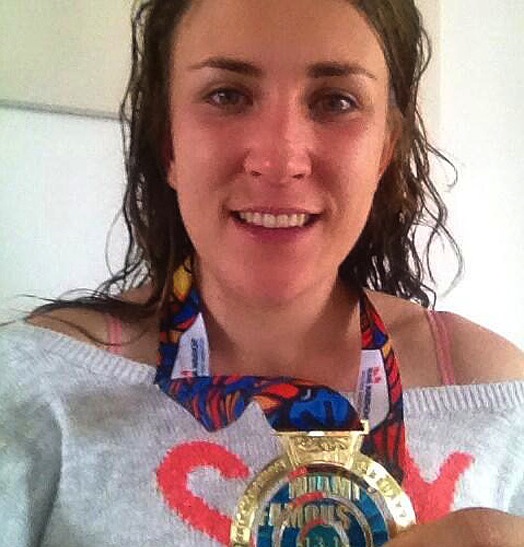
Annalise with her Miami Half Marathon medal this afternoon
"I had some goals for how I wanted to sail the medal race and where I wanted to finish," said Railey. "I wasn't thinking about the – 'what if' - if I do this, I could lose the event. It was more about what I was going to work towards so I can keep progressing for Rio, and what we will face there."
Kinsale's Sorcha Ni Shuilleabhain also attended in Miami scoring 30 (46) 39 41 39 42 to place 45th overall.



























